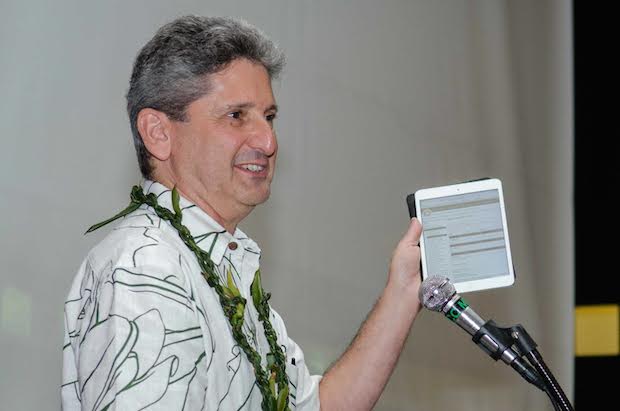The University of Hawaiʻi has adopted an executive policy on sustainability that sets a number of significant goals, including achieving carbon neutrality by 2050, and provides a framework for the university to fulfill its commitment to sustainability in operations, curriculum, scholarship and engagement.
The new policy was approved electronically by UH President David Lassner at the kickoff of the 3rd Annual Hawaiʻi Sustainability in Higher Education Summit, a gathering at UH Mānoa of students, faculty, staff and administrators from throughout the state. The policy provides a comprehensive framework for goals, metrics, planning, coordination and oversight across the many dimensions of sustainability.
- The policy is available online at http://go.hawaii.edu/8G.
UH President Lassner said, “I want to thank the many students, faculty and staff from across the UH System who have contributed to creating our university’s sustainability policy. We have set bold goals for ourselves, and we are committed to putting in place the framework to achieve success as we become a model for global sustainability and help the State of Hawaiʻi meet its energy independence goals.”
Setting the course

In January 2014, the University of Hawaiʻi Board of Regents incorporated sustainability explicitly within the university’s mission by stating: “Within its unique geographical location, the university will serve as a leader in how it stewards the resources of the islands and the world for the benefit of all. The university shall be a global leader and model for the integration of sustainability throughout its teaching, research, operations and public service.”
The regents then tasked UH administration with advancing implementation. The new executive policy was developed by a diverse group of students, faculty and staff from across the system and will serve as a guiding framework for the university’s 10 campuses to implement sustainability plans moving forward.
Sustainability targets
In order to achieve more sustainable operations with reduced negative environmental impact, the policy sets specific targets for reducing energy consumption and increasing utilization of renewable energy in 5-year increments, with a goal of becoming carbon neutral by 2050. Other highlights of more sustainable operations include striving for LEED Gold in new construction projects, developing energy management systems, tracking water conservation, reducing transportation impact, increasing utilization of local food products and establishing a Green Purchasing Policy.
The policy calls for curriculum development across the UH system that will help to equip UH graduates with the skills to thrive in and contribute to the growing global green economy. It also identifies the importance of supporting sustainability research and scholarship, with appropriate integration into UH teaching and learning.
Sustainability must be advanced in partnership with the communities in which UH campuses are situated and with aligned organizations of all kinds. The policy calls for UH sustainability initiatives to embrace Hawaiʻi’s indigenous wisdom and host culture.
Planning, coordination and oversight are also outlined in the new policy. It calls for a new Office of Sustainability, Sustainability Council and Sustainability Curriculum Council to lead and coordinate systemwide efforts across the 10 campuses of the University of Hawaiʻi.
At the Sustainability Summit President Lassner also electronically signed on to the American College and University Presidents’ Climate Commitment, an international declaration signed by more than 680 institutions of higher education committed to accelerate progress towards climate neutrality and sustainability by empowering the higher education sector to educate students, create solutions and provide leadership-by-example for the rest of society.


